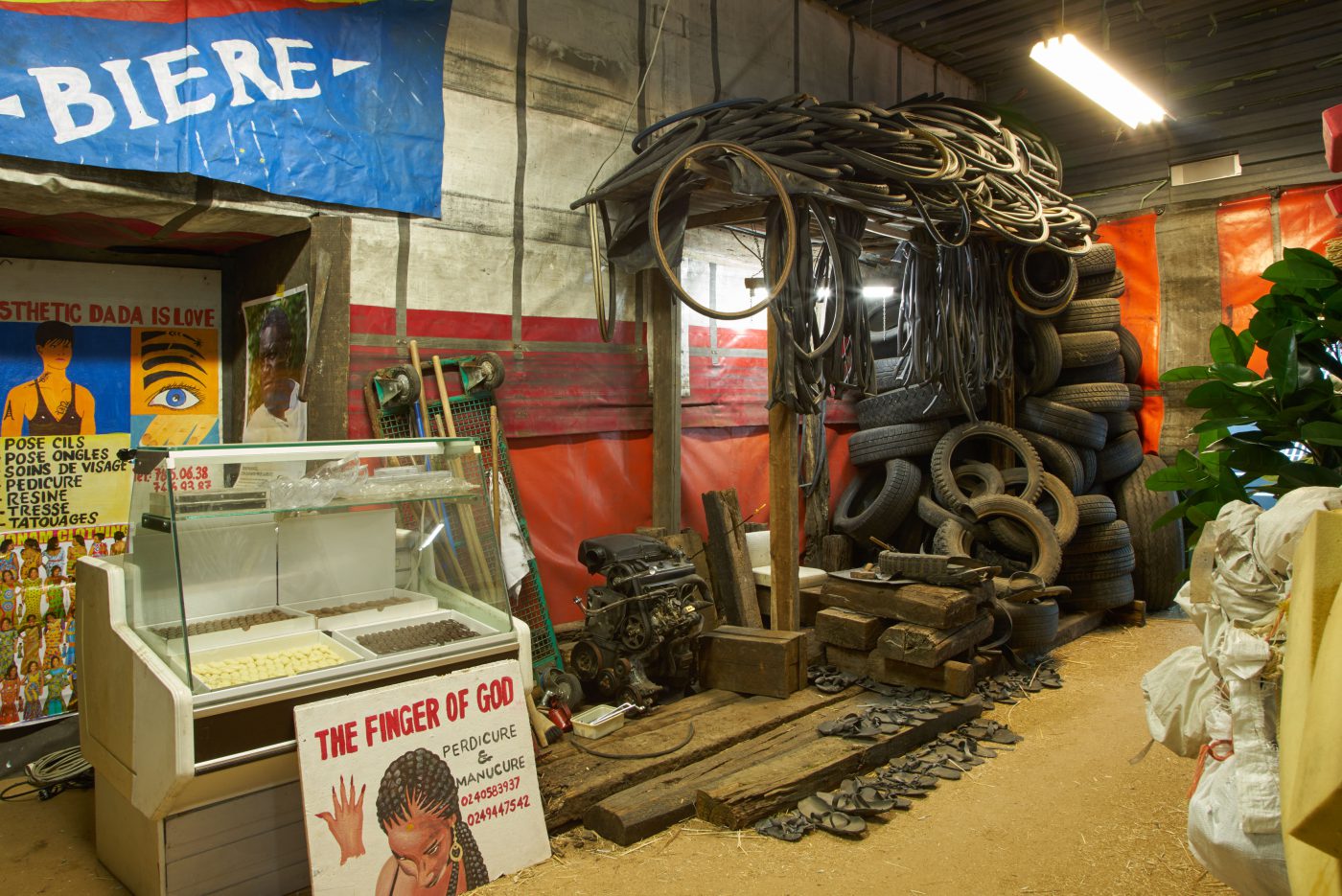
The museum as a shelter for refugees – Christoph Büchel at SMAK, Ghent
WEEKEND LONG READ Some exhibitions require time to reflect. Ory Dessau writes about the most important exhibition he has seen this year: Christoph Büchel’s From the Collection | Verlust der Mitte at S.M.A.K.
Christoph Büchel’s From the Collection | Verlust der Mitte (Loss of Center) is an immersive, multi-part, total installation divided into three interlinking sections which occupy the whole ground floor and the surrounding areas of Ghent’s City Museum for Contemporary Art (SMAK). It is an event of boundlessness and simultaneity undermining the distinction between different times, places, occasions, practices, and contexts.
Section One: Sheltered Collection
The first section literally blends a display of foundational works from the collection of SMAK with an emergency public shelter, or rather, a shelter for refugees. The display is a sequence of five rooms. The first and largest room presents works by CoBRA artists such as Asger Jorn, Karel Appel and Corneille, including Jorn’s coded painting Verlust der Mitte (1958), after which the project is titled. Jorn’s painting is a ritualistic, drifting topography marked by a palette of boiling colors engendering vibrating deformations of bodiless faces, skulls, masks moving toward and away from each other. Ironically enough, Büchel placed Verlust der Mitte in the middle of the central wall of the first room, turning its title into an independent element.


The second room is dedicated to “Jeune Peinture Belgique” (Young Belgian Painting), outlining the different directions that European abstract painting of the 1950’s was going through, such as Informel, Taschisme, and Lyricism. The third room consists of works by Pop artists such as Evelyne Axell and early David Hockney, as well as by décollagists such as Mimmo Rotella. The fourth room displays works by European and American Minimal/Conceptual artists such as Dan Flavin, Sol LeWitt, John McCracken and Francois Morellet, and the fifth room exhibits works by unclassifiable European role models such as Panamarenko, Marcel Broodthaers and Joseph Beuys.
The display serves as a five-part introduction to the ‘building blocks’ of the museum’s collection, arranged chronologically in a museological, art-historical manner. Yet, Büchel’s intervention in the museum’s collection opens it onto an anarchic horizon. On top of the display he superimposed another space – a setting of a shelter for refugees. He covered the floor of all five rooms with rows of old mattresses, which were scattered all over – around, between and inside the displayed works. Büchel paired the mattresses with used blankets, suitcases, clothes, bottles, mobile phones and additional items forming a materialized image, an objectified projection, of a temporary public shelter.
The effect of infusing the two spaces, one into the other, is disturbing, apocalyptic even.
The effect of infusing the two spaces, one into the other, is disturbing, apocalyptic even. It suggests a state of emergency, a loss of code, a violated integrity. It is more than a gesture of institutional critique deconstructing the ideology of the white cube and of museal display – it politicizes the artistic and cultural heritage of SMAK, and consequently of Modernism in general, situating them within and exposing them to the bleeding context of the current European refugee crisis and its historical roots in European colonialism. It dismantles the protective shield of the supposedly-autonomous aesthetic experience and physically intrudes it, transforming the museum’s collection, the museum itself, and eventually the space of art, into a refugee – a placeless, disposed, superfluous entity. It radically alters the displayed works, rendering them and the symbolic order that validates them vulnerable, unfamiliar, forgotten.


The already interrupted situation is further interrupted by a painting hung on a wall adjacent to Beuys’ Boter en bijenwas (Butter and beeswax) (1975-1986). Beuys’ work is a sculptural, enlightenment-driven, culture/nature equation – a glass case with two parallel vertical stacks, one of cardboard boxes with packaged butter and the other of slabs of beeswax. The interrupting painting next to it is John R. Bastard’s Exploration Chromatique (Chromatic Exploration) (1966), whose accompanying label does not indicate the artist’s biographical details. The painting is in fact a printed canvas with an image of a color chart created by French physician, anatomist and anthropologist Paul Broca (1824-1880), as part of a colonialist, pseudo-scientific race study which catalogs the different skin shades of African men. The name John R. Bastard is an allusion to Henry Morton Stanley (1841-1904) – the explorer of the Congo Free State – who was born as John Rowlands. Bastard’s borrowed color chart was implanted into the display by Büchel, who incorporated this fictitious artist and object to reveal (or rather re-conceal) the true history underlying modern Europe, and in particular, modern Belgium.
[figure buchel04]
In the wall-text welcoming the viewers to the five rooms of the first section, Büchel returns to the initial public opening of SMAK’s collection. The wall-text names Henry Lecube as the collection’s first curator and quotes from his inauguration speech: “The collection is unique in its kind. It has nothing to hide and no secrets, and is not beholden by anyone except its founders.” A closer investigation detects that H. Lecube never existed. His name is an anagram on Büchel’s name, and his statement is borrowed from King Leopold II (1835-1909), who said the exact same thing on the Congo Free State: “The Congo Free state is unique in its kind. It has nothing to hide and no secrets, and is not beholden by anyone except its founders.” Büchel’s wall-text disguises Leopold’s statement, which in itself disguised the atrocities he conducted as part of his colonial exploitation of the area known today as the Democratic Republic of the Congo. Replacing the name of the private colony of King Leopold II by the word ‘collection’, the wall-text disguises the disguise.
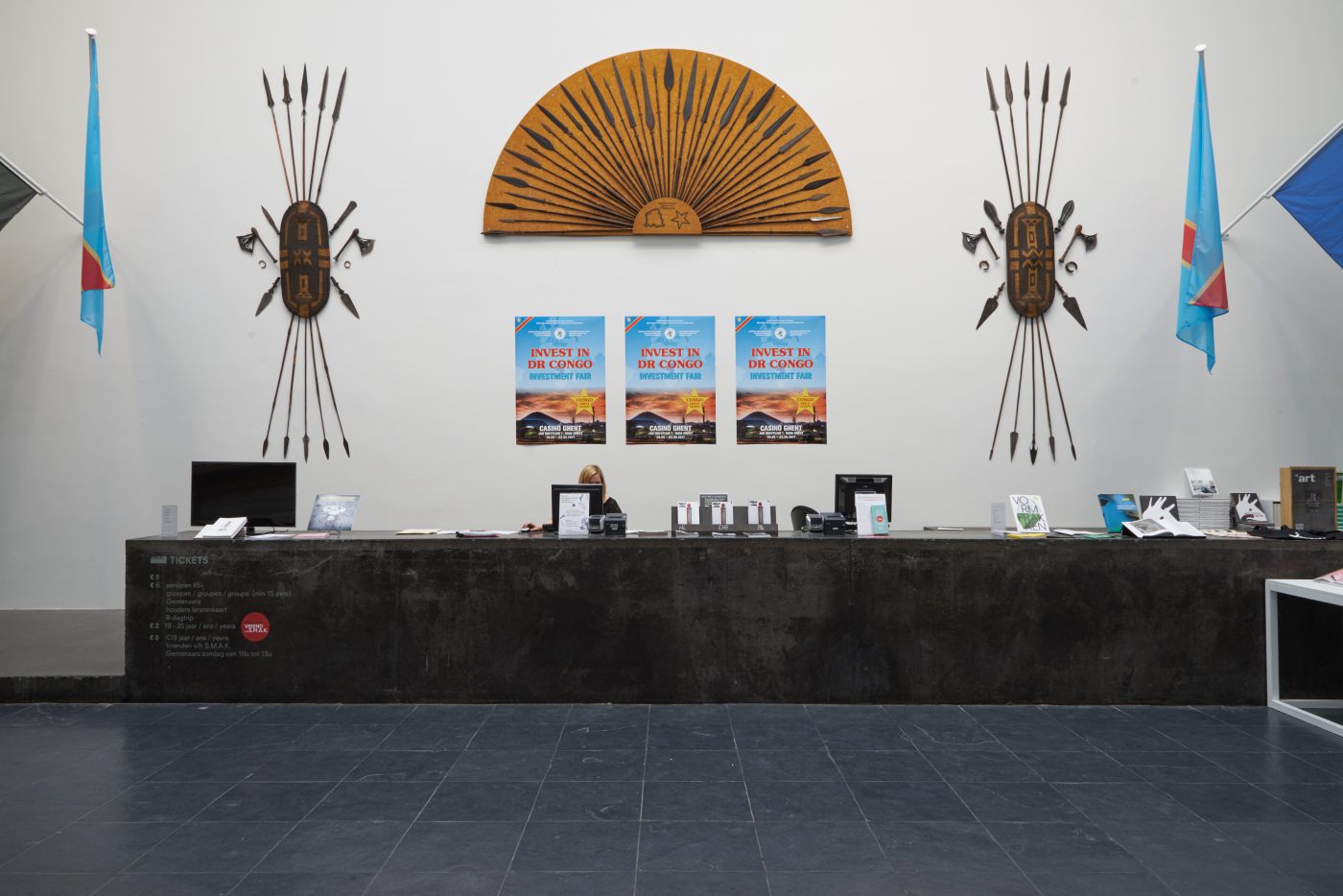
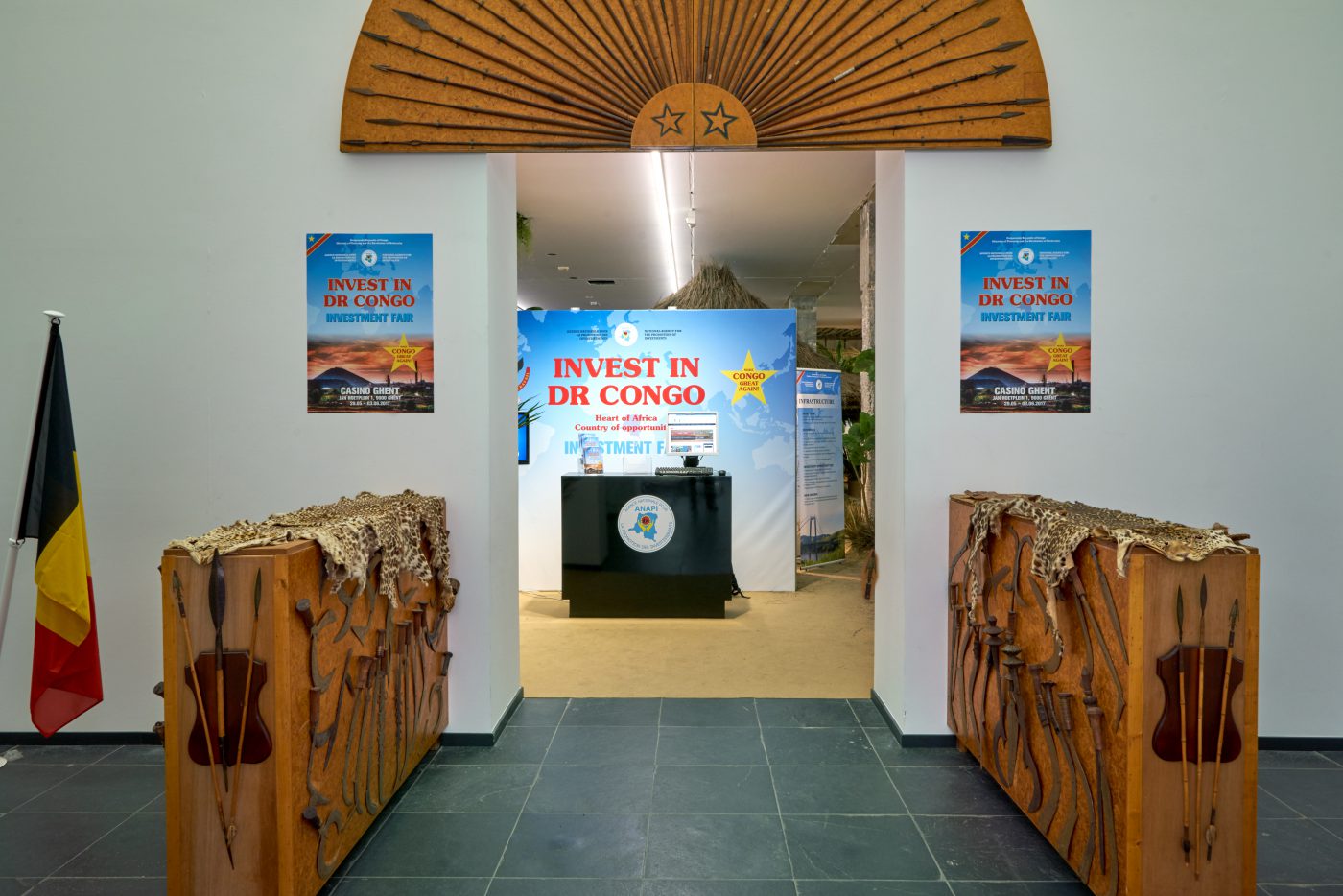
Section two: Investment Fair, World Expo
The second section begins in the lobby of the museum with a display of African spears, shields, flags and posters of an investment fair organized by ANAPI – Congo’s national investment promotion agency – urging the viewers to: “Invest in DR Congo.” Upon entering the space of the second section the viewers are caught in a fully-fabricated hyper-realist environment. The environment is both fragmentary and unified. It combines replicated trade-fair information booths of real natural resource commodity companies describing their exploitative activity in Africa as investment and philanthropy; a replica of the rural Congolese village presented in World Expo Brussels 1958 (one of the investment fairs of that time), which served as an investment fair; a display of Congolese artifacts from a Belgian mission museum, and of modern African makeshift stores and situations.
The booths draw a direct line between Europe’s exploitative colonial past and the globalized capitalistic systems of Africa today.
Simulating an African investment fair within a replicated Congolese village, demonstrating a variety of investment channels, the information booths advertise real natural resource commodity companies such as Glencore, Groupe Forrest International, Fleurette Group and SDA/SDAI. Using their own promotional video-clips, info sheets and brochures, the simulated investment fair does not disclose the fact that these companies loot Africa’s natural resources, but repeats the cover-up stories through which the companies advertise themselves. The booths draw a direct line between Europe’s exploitative colonial past and the globalized capitalistic systems in Africa today.
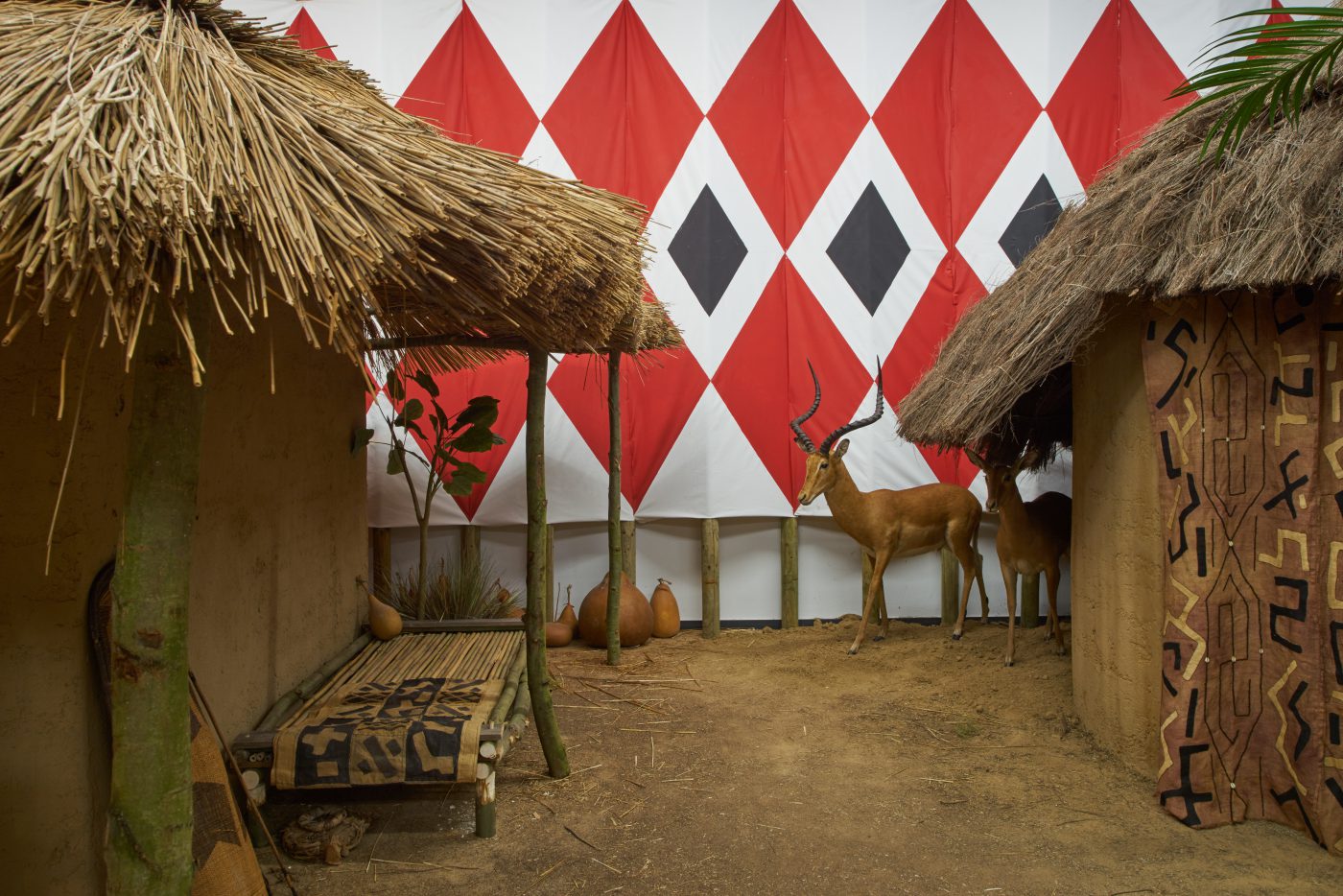
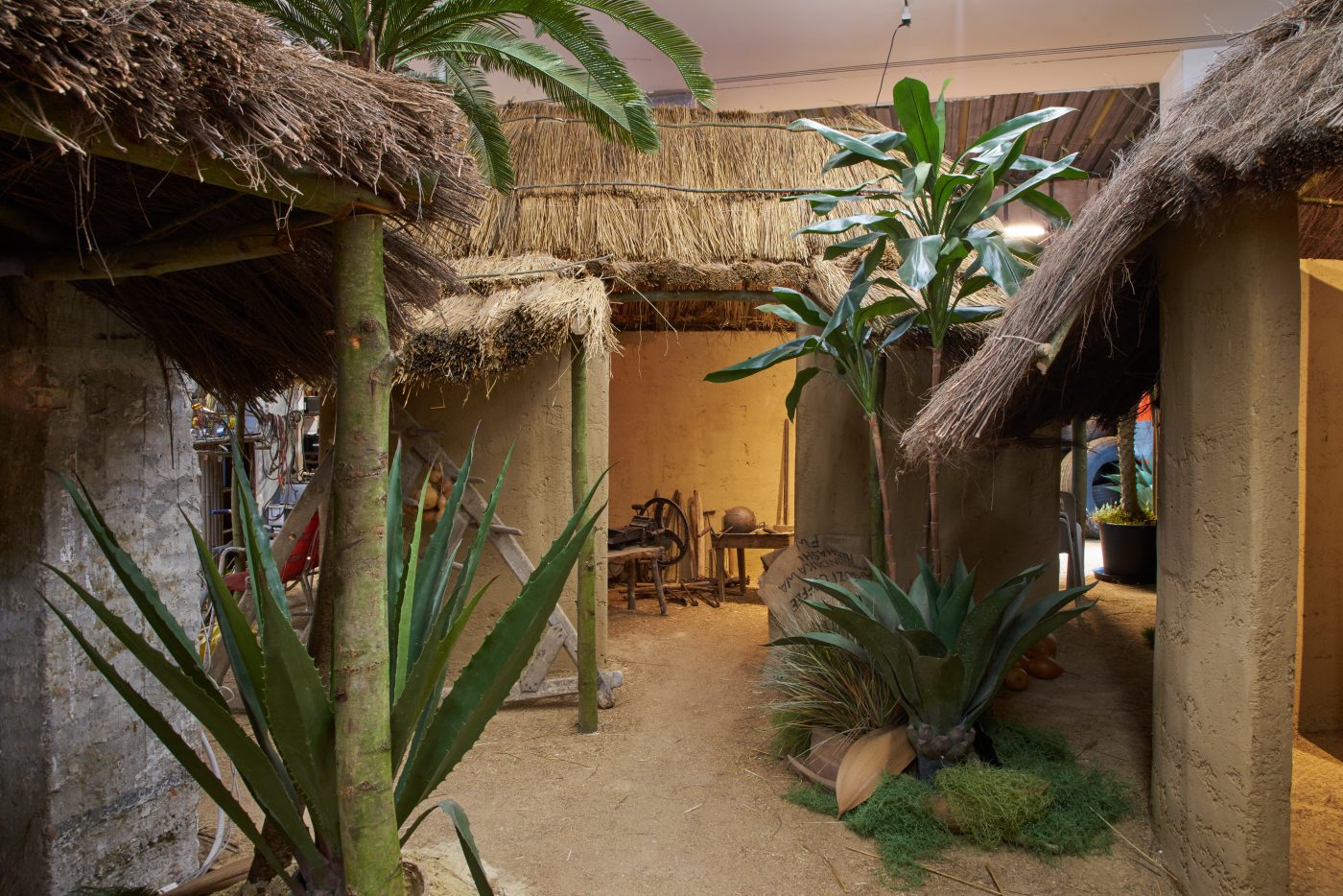
The replicated segment of the rural Congolese village is also a replica of a replica. It reconstructs a replicated Congolese village featured in Europe’s World Expos during late 19th century to mid-20th century. Büchel’s environment specifically refers to human zoos arranged for World Expo Antwerp 1885 and World Expo Brussels 1897. It repeats the replicated huts and the layout of World Expo Brussels 1958, which exhibited replicas of Congolese villages populated by real dislocated Congolese men and women. It also refers to World Expo Ghent 1913, which took place in the building that decades later would become SMAK. At the exact same location near the museum, where the Senegalese village with its human zoo was erected for World Expo Ghent, Büchel, together with real refugees, erected a tent encampment replicating a part of the dismantled ‘Jungle’ of Calais.
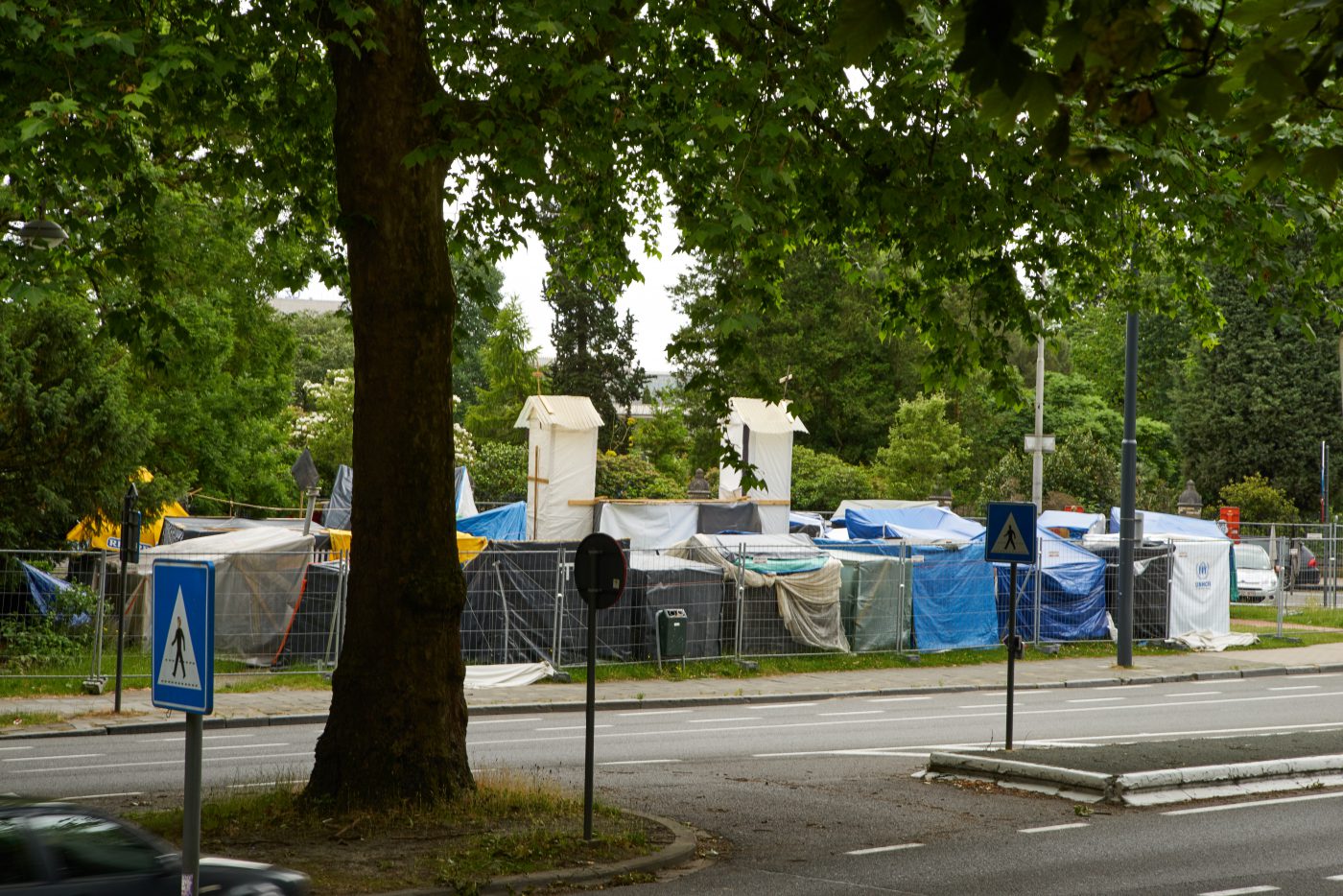
The ethnological presentation of Congolese artifacts shares a different kind of colonialist profiteering disguised as scientific research. Büchel and SMAK loaned a replica of a famous Luba mask from the MAS in Antwerp, an item which belongs to the collection of the Royal Museum of Central Africa in Tervuren. The museum in Tervuren is currently undergoing a period of renovation, which, as pointed out in the company’s promotional video-clip, is sponsored by Philippe de Moerloose’s SDA/SDAI. Installed in a jungle of artificial plants, the ethnological display (and the replica of the rural classroom in front of it) not only highlight the historical connection between modern methods of classification and the European colonization and Christianization of Africa, they also inform us that current companies involved in the depletion and destruction of Africa’s natural resources, are the same companies supporting the restoration and commemoration of African heritage. In this sense, their strategy follows the exploitation/philanthropy pattern developed by King Leopold II, who was the looter of Congo while also founding the Royal Museum of Central Africa in 1897.
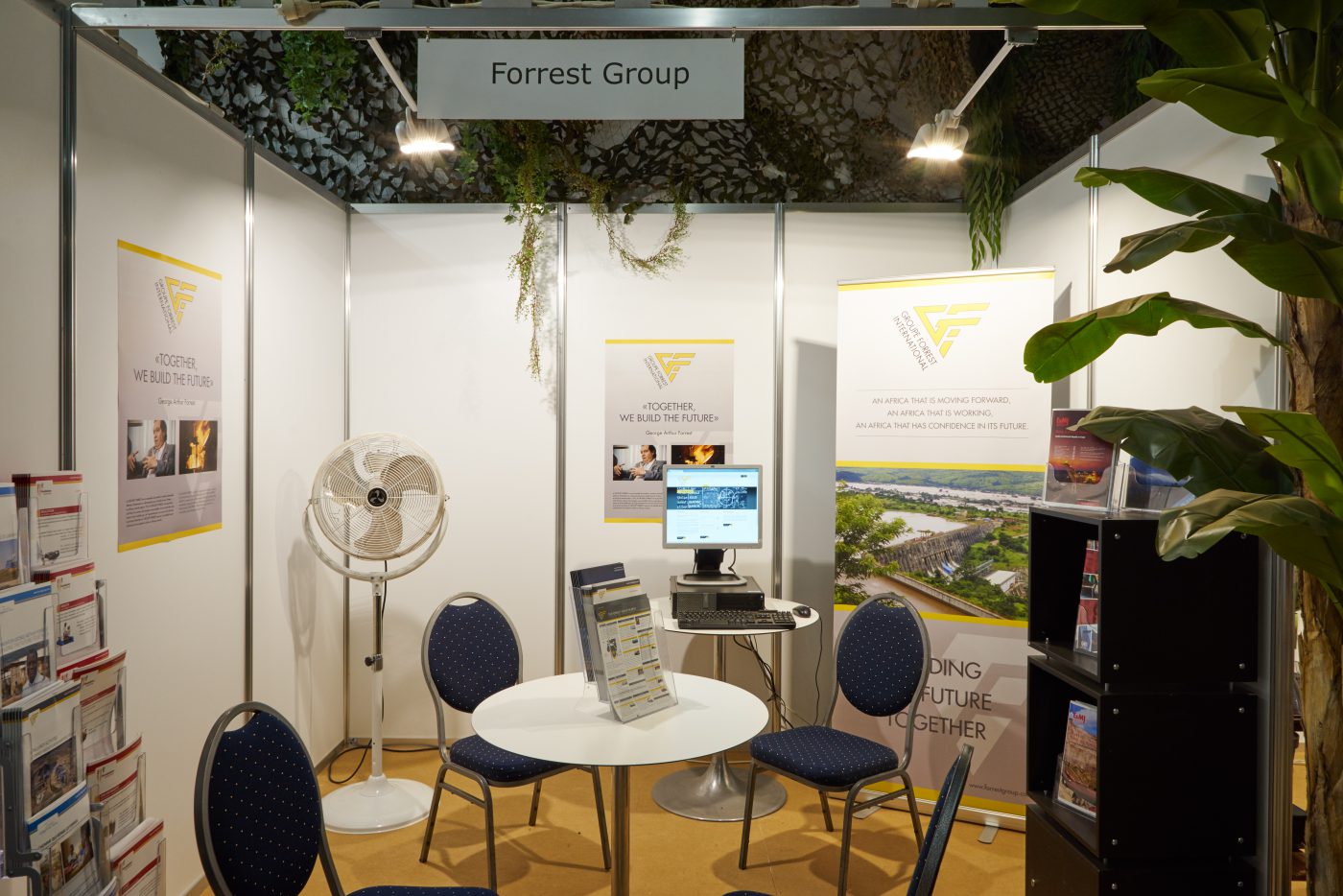
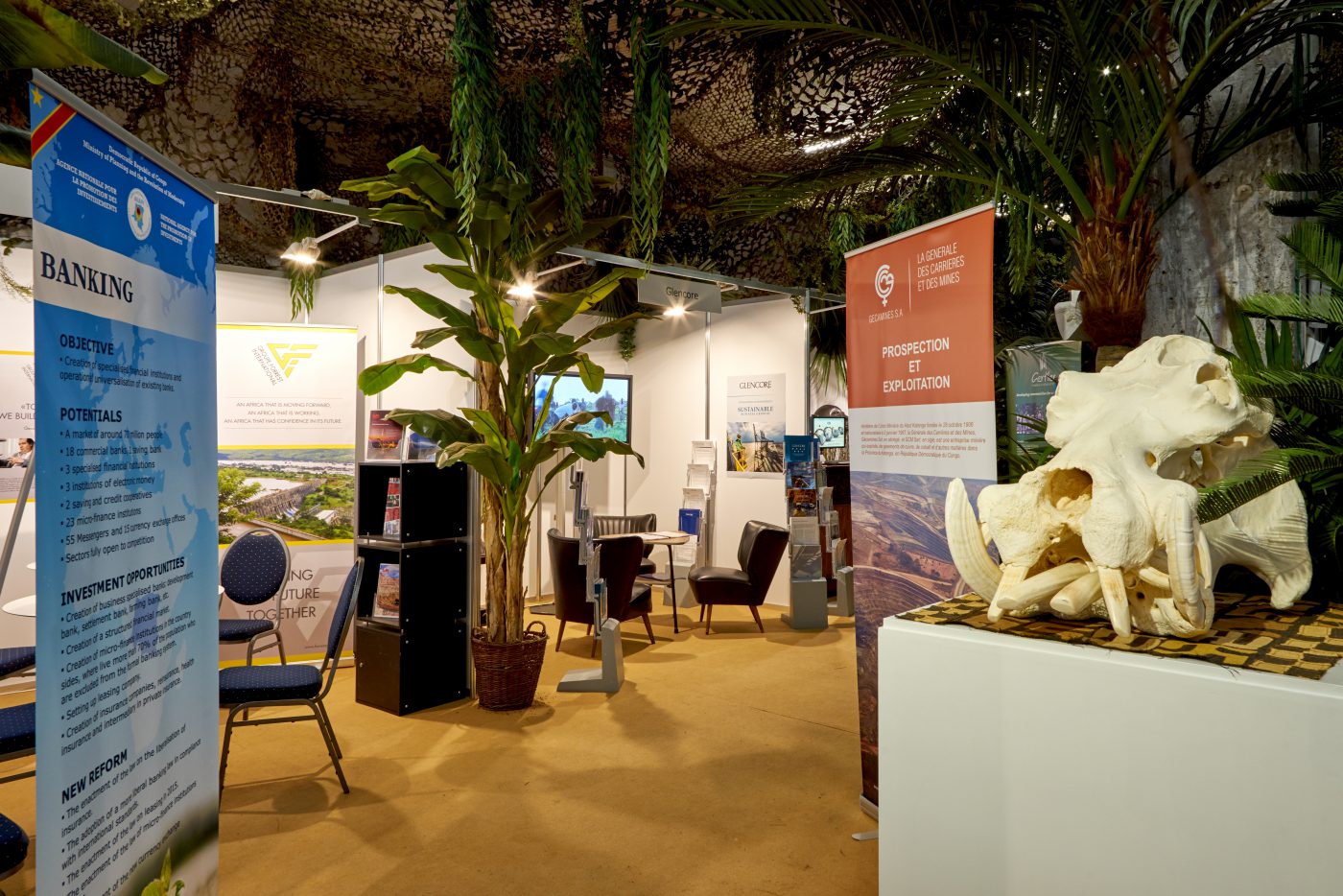
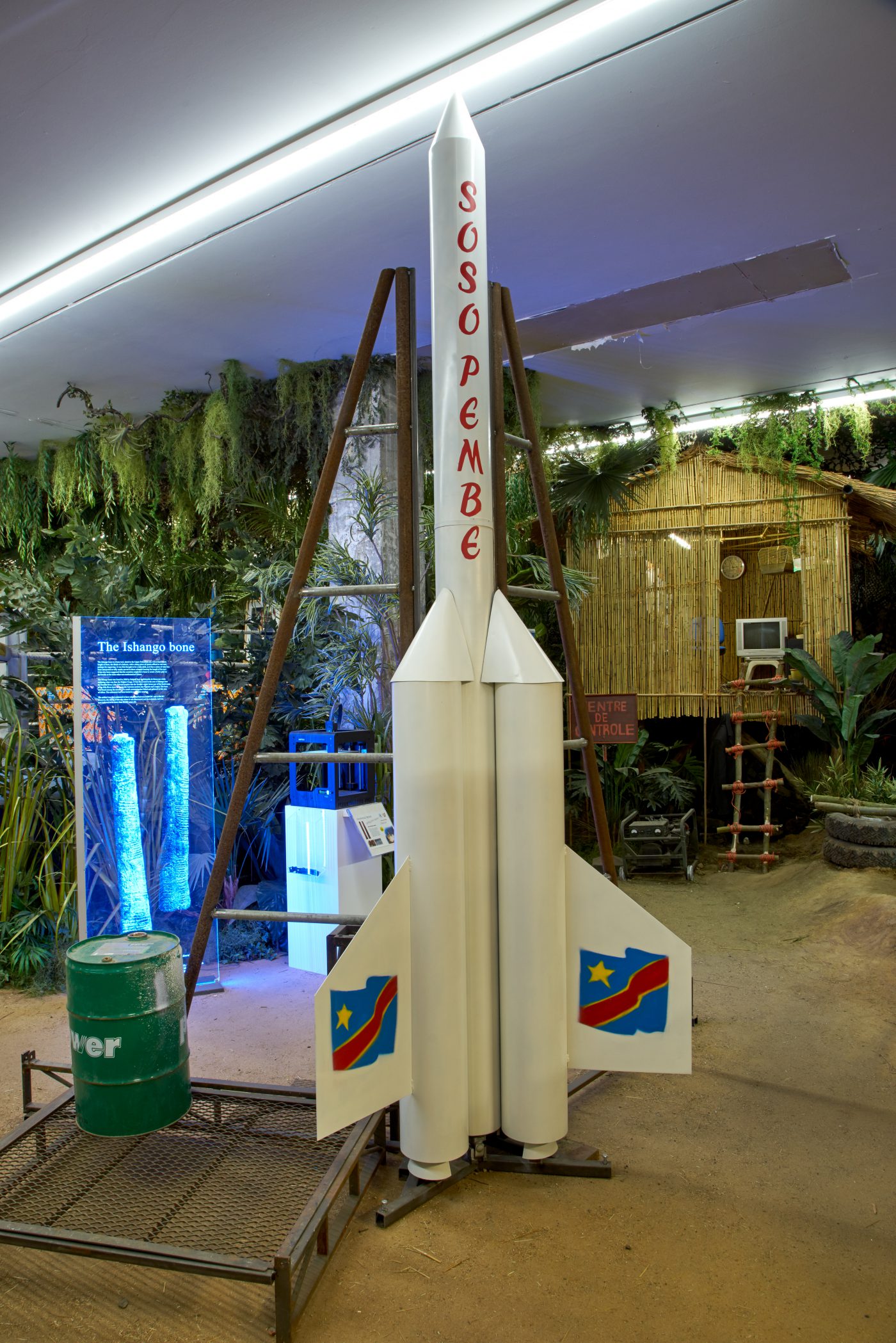
Additional segments address the aberrant aspects of Congo’s post-colonial history. One of them is comprised of a space rocket positioned vertically in front of a replicated hut with a pond next to it. Based on a replica from World Expo Brussels 1958, the hut contains, among other things, a monitor on top of a stool, computer screens, speakers and other low-tech devices, and an empty birdcage. It looks like a provisional, Afro-Futurist control room replicating the actual existing interior of the Congolese Troposphere space program. The monitor displays footage of the current Troposphere makeshift rocket tests, and a failed attempt to launch the German designed rocket OTRAG-1 into outer space. This experiment was held on Congolese soil in 1977. It was the culmination of the space program initiated by military dictator and President of the Democratic Republic of the Congo Mobutu Sese Seko (1930-1997), who visited World Expo Brussels 1958 as the secretary of Patrice Lumumba (1925-1961) – the first democratically elected prime minister of Congo. As observed in the failed space experiment and was taught by history, Mobutu’s theater of African exceptionalism and Authenticité, leading him in 1971 to change the name of the country to Zaire, ultimately masked broader schemes allowing the continuous exploitation of Congolese lives and resources under the guise of anti-colonial self-determination. His murderous kleptocratic regime enabled Belgium and other colonial powers to benefit from Congo’s natural resources while remaining unaccountable.
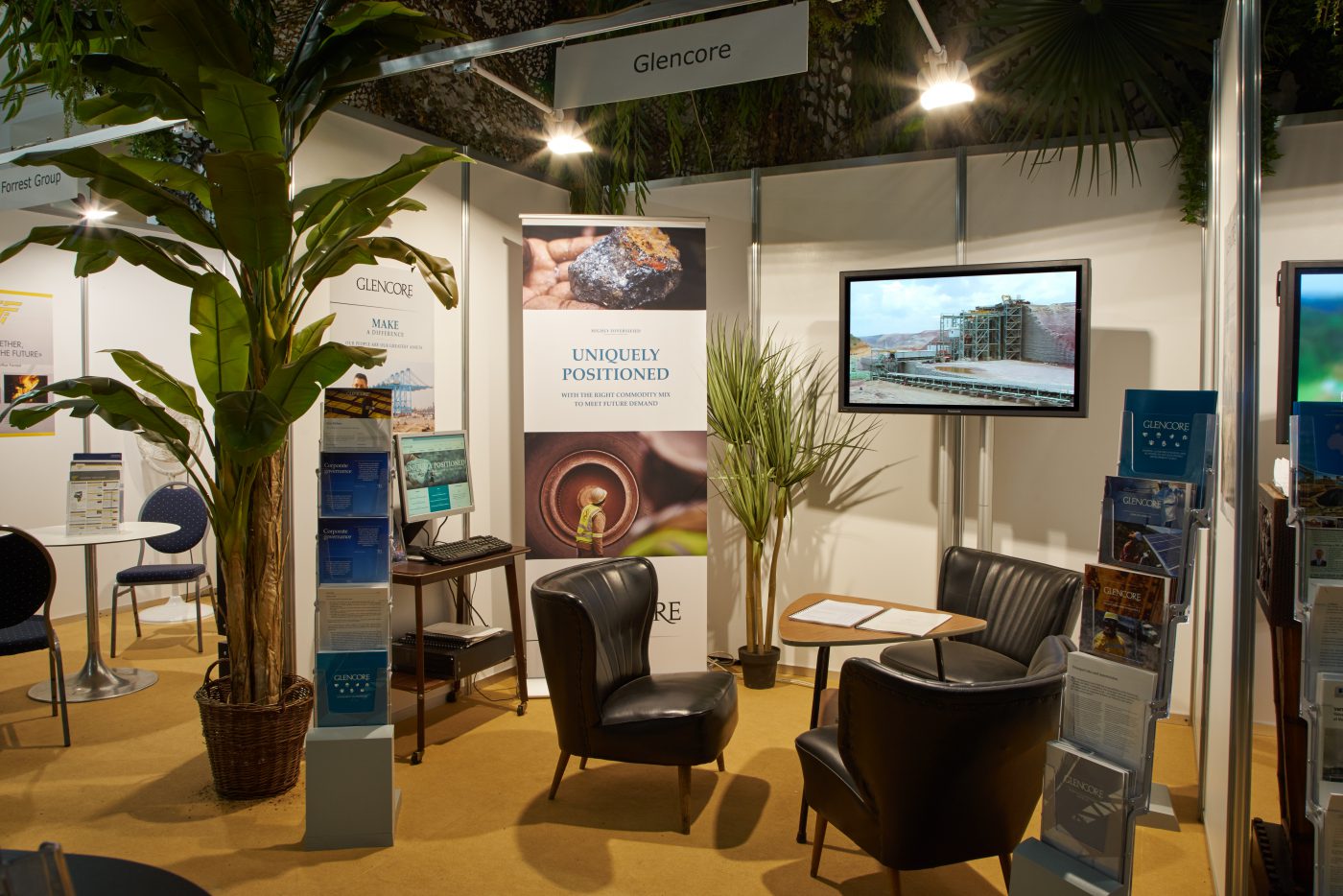
An additional segment conveying Congo’s recent history is a boxing ring designed as a setting for a business conference organized by ANAPI and as the stage for a political rally supporting Joseph Kabila, the president of the Democratic Republic of the Congo in the last sixteen years. The ring inevitably recalls Mobutu’s propaganda stunt known as the ‘Rumble in the Jungle’ – the historic world championship fight Muhammed Ali v. George Foreman, which took place in 1974 in Zaire. It also recalls the 1913 European boxing championship in the Royal Casino in Ghent – the earlier phase of SMAK’s premises.
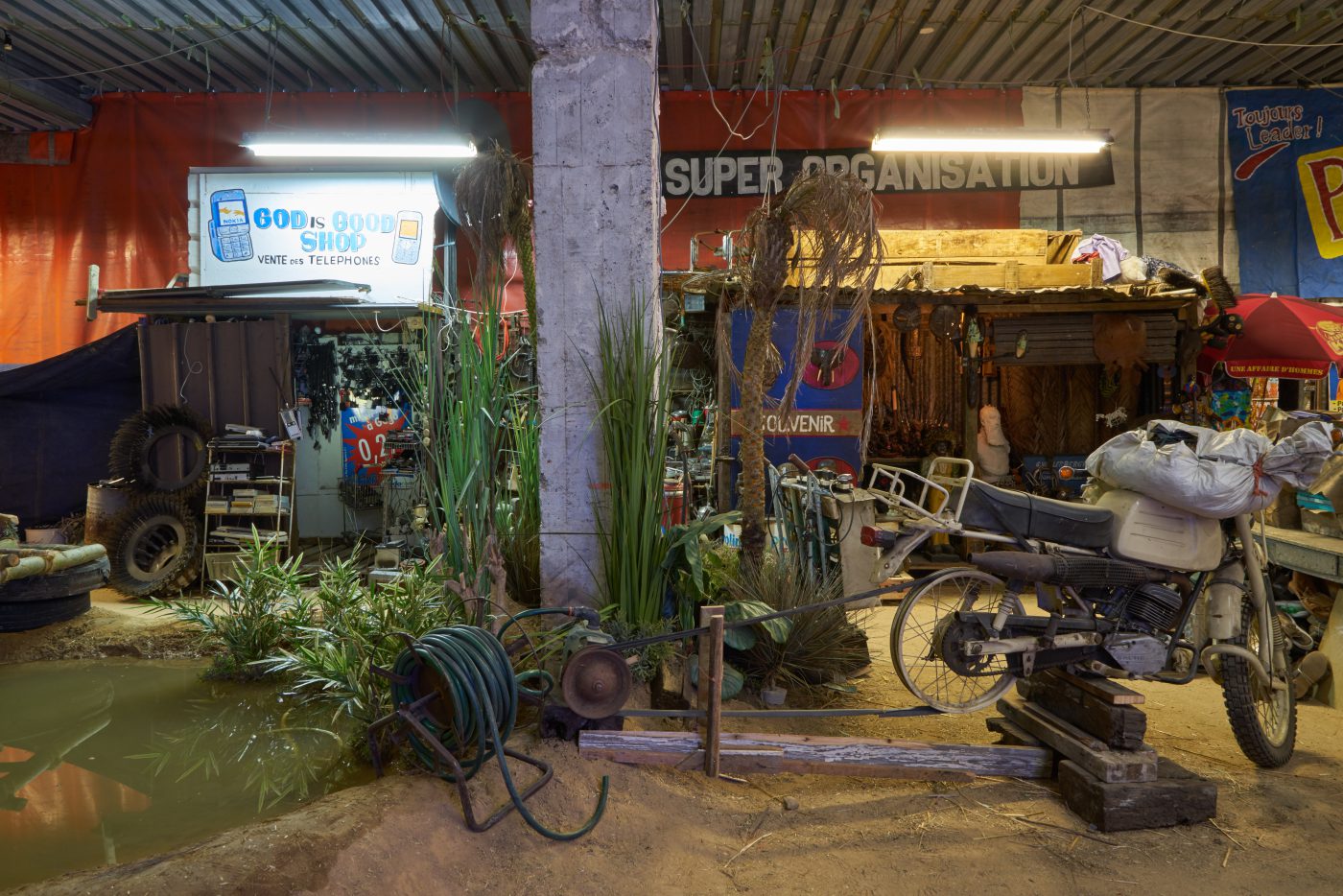

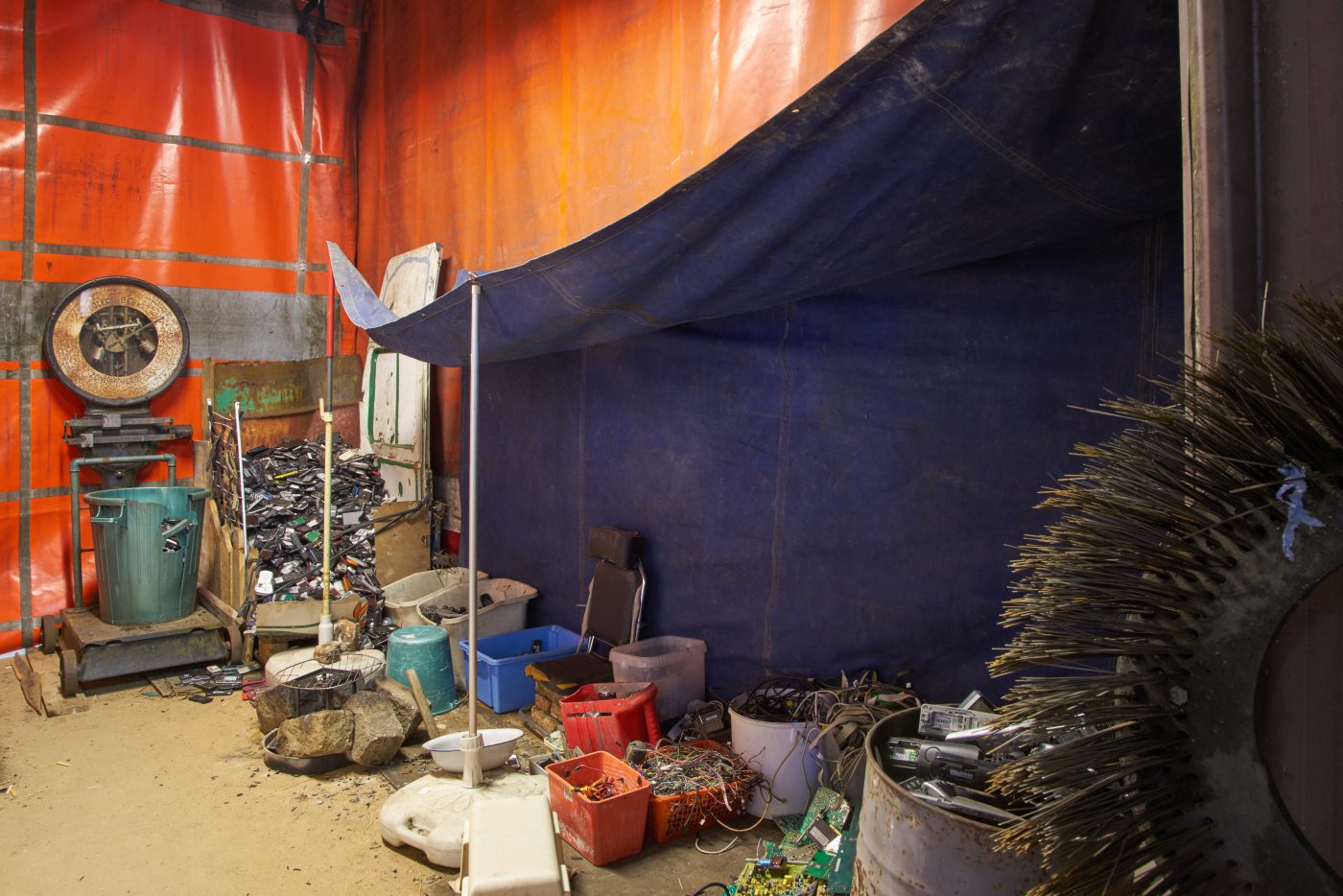
Between the second and the third section is a sequence of installations, among which a group of makeshift stores with piles of recycled car tires and mobile phones, and with a crowded display of fake African souvenirs. The piles signify the modes in which Congo’s natural resources of rubber and metal are being processed by the Western car and electronic industries. Inside the makeshift souvenir store Büchel implanted an original bust of King Leopold II from the Belgian Senate, and a bronze cast by Belgian sculptor Arsène Matton (1873-1953) taken from a series depicting Congolese races.
Section three: Operative Shelter
During the period of the exhibition the third section functioned as an active residential area inhabited by state-authorized refugees from Middle-Eastern war zones. Büchel transformed major part of the museum’s ground floor into a set of rooms and spaces: a club with a stage and pool table; a community center with public workshops, and a kitchen with dining area. The set was completed with private bedrooms and bathrooms that were inaccessible to viewers, and only partly observable through windows outside the museum. Büchel rearranged the museum’s architecture and purpose into a living social structure to which the viewers had no access, or rather, did not belong. He provided a place of shelter for some and a sense of dislocation, of being a refugee, for others.
He provided a place of shelter for some and a sense of dislocation, of being a refugee, for others.
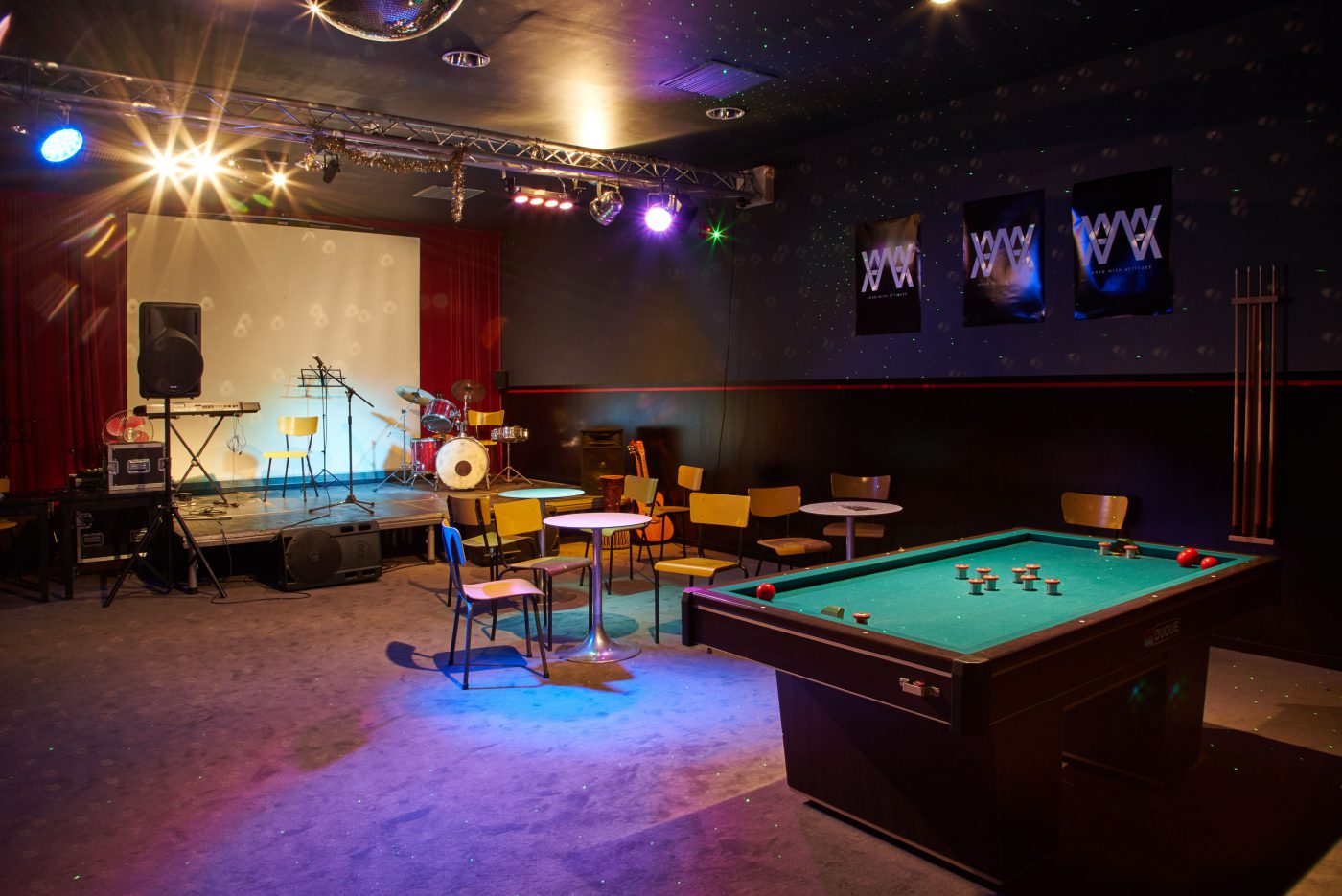
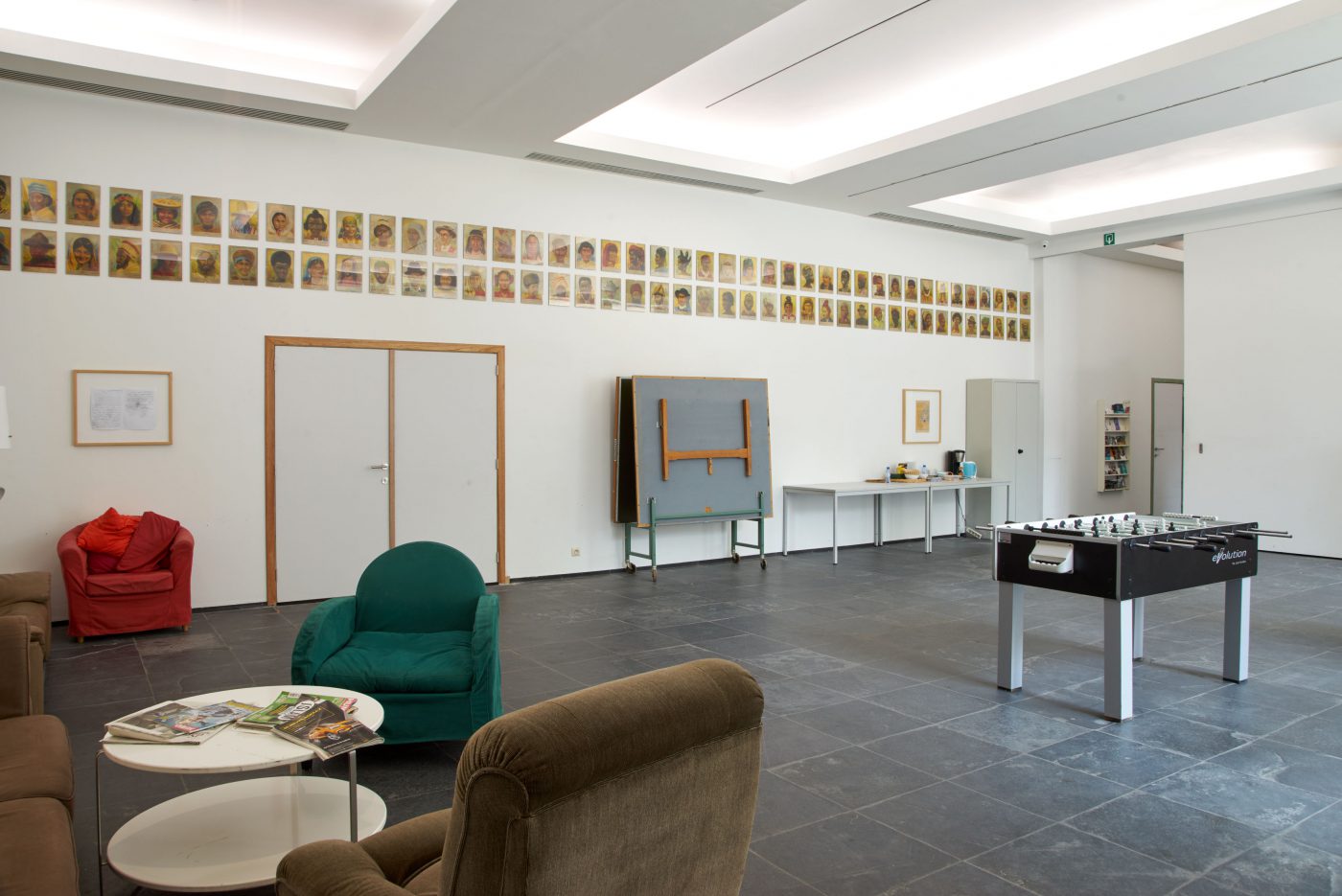
If the third section was fully operative, the space of the first section was oscillating between potentiality and actuality. It was equipped enough to act as an emergency public shelter, but was never meant to be. Its activity was negative, foregrounding the viewers’ social passivity and political impotency regarding worldwide crises.
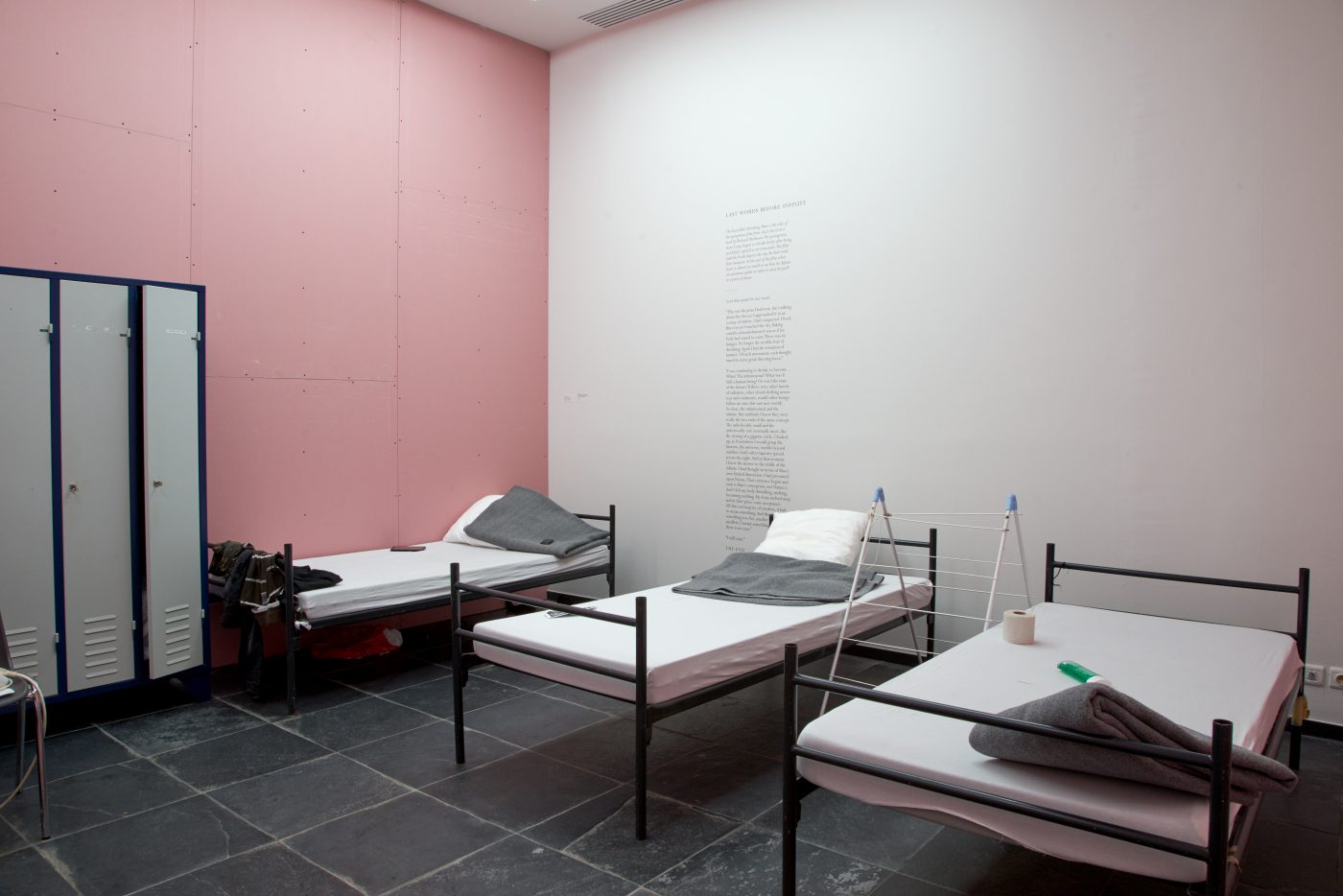
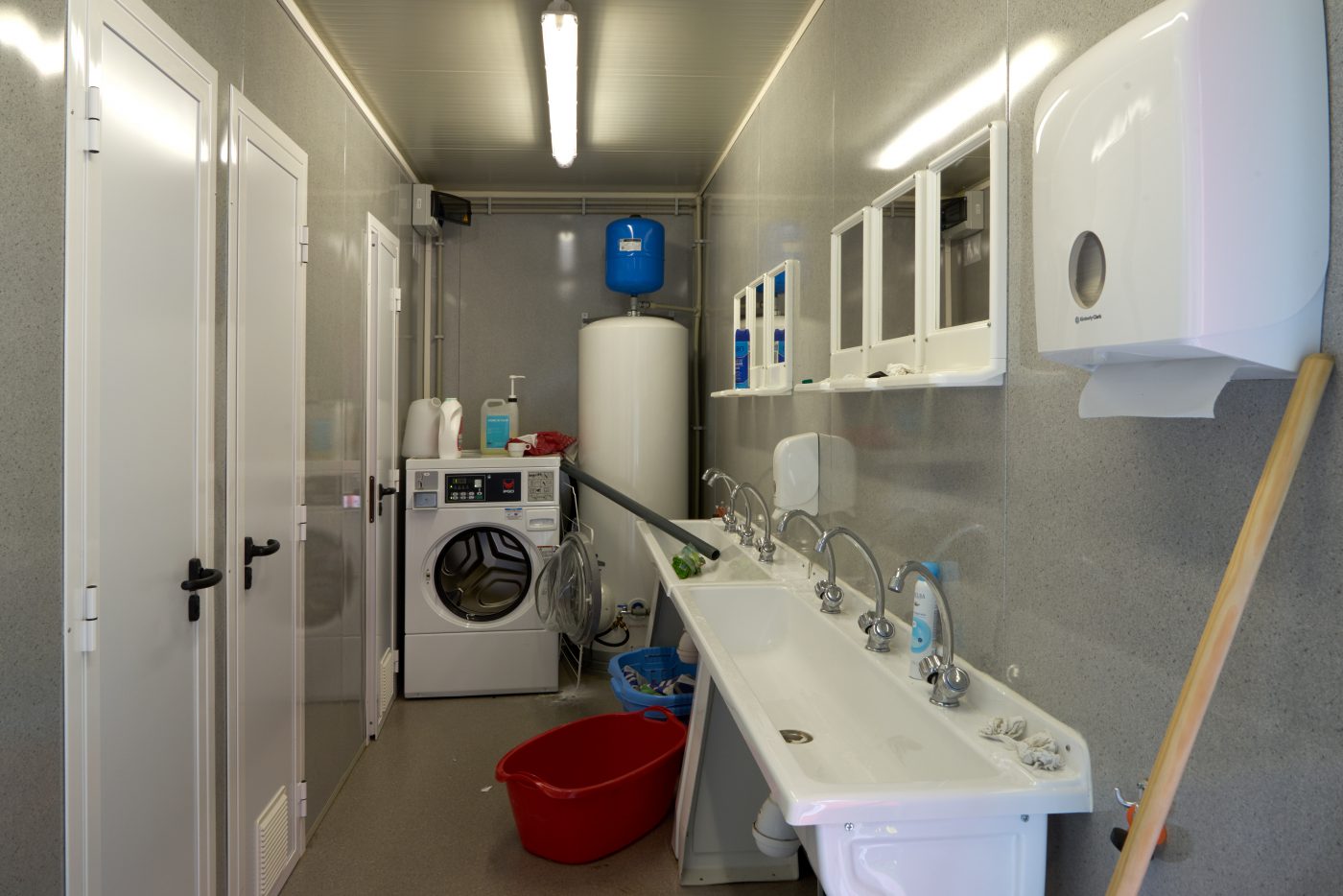
While living in the museum, the group of refugees rebuilt parts of the Calais camp on the historical site of the African village of World Expo Ghent, and engaged in workshops focusing on the history of Congo. They also formed an excavation site demarcated by a tent and a fence with an attached sign from the ‘Federal Agency for the Reception of Asylum Seekers’ (Fedasil), and in cooperation with the ‘Association Internationale Africaine’ (International African Association) (AIA) – a derivative of Leopold’s organization in his foundation of the Congo Free State. The refugees dug into the ground behind the museum’s rear entrance seeking the archaeological remains of an old citadel buried below. In addition to the archaeological findings, onsite was a small working table displaying b/w photographs of the former citadel. As mentioned above, before it became a museum, SMAK’s building was a Royal Casino. The casino was built on top of the ruins of the citadel for the occasion of World Expo Ghent 1913. Büchel replaced the inscription S-M-A-K on the museum’s portal with the original inscription C-A-S-I-N-O, thereby establishing a connection between the citadel, the museum and the building’s previous phase as a casino.
"It emphasized the fact that Belgians, and Europeans in general obscure their history as well as their historical present, and it also produced the project as a chain of discoveries – sudden, unpredicted, and therefore traumatic, occurrences".
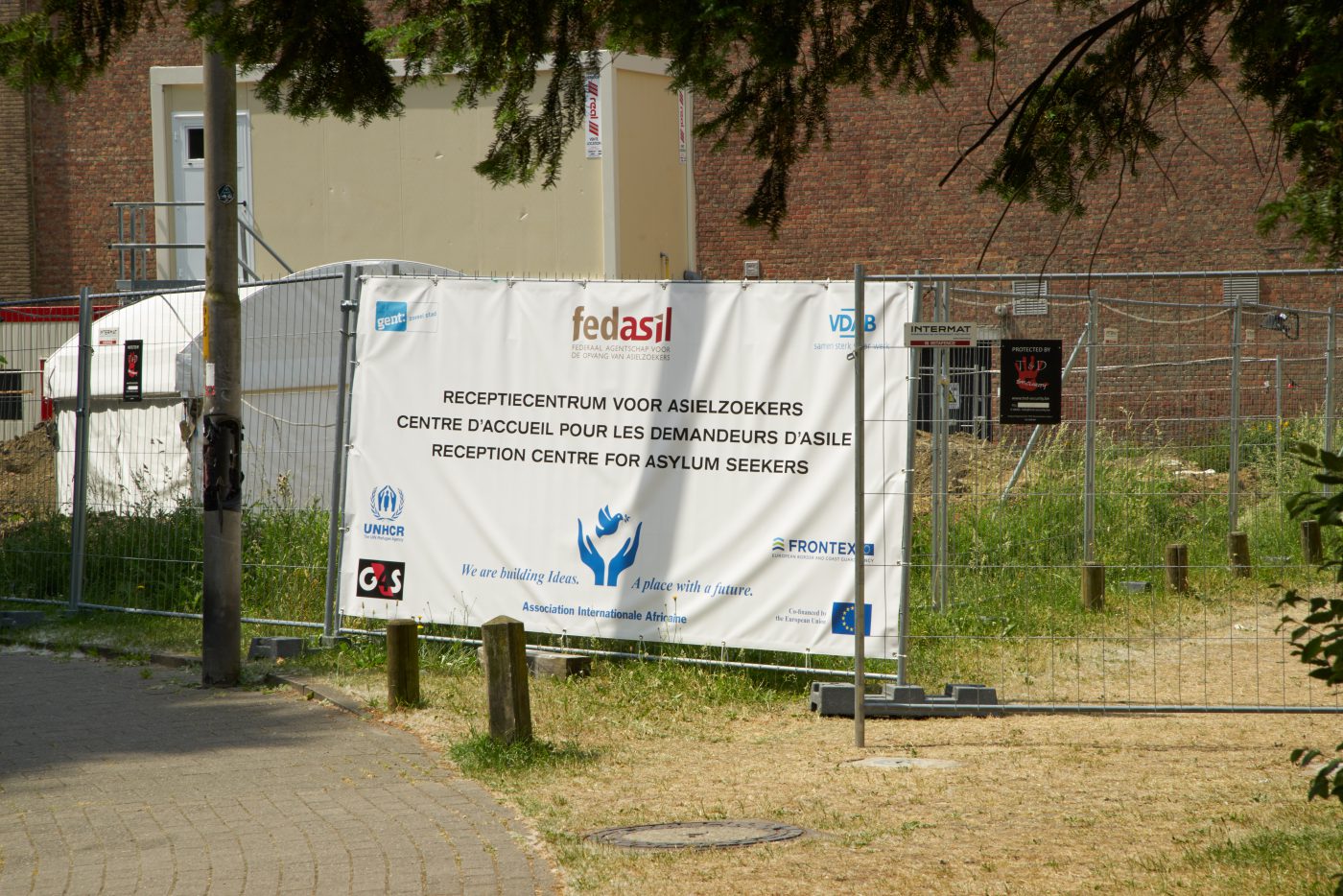

As redemptive as Verlust der Mitte appears to be, it is not a three-dimensional archive. Rather, it is an act of self-obscurity. The museum’s press release only announced half of the first section and completely ignored the other two. On the museum’s website, the project was communicated as an investment fair and a list of public workshops conducted by the refugees. Büchel himself is credited as the curator of the museum’s collection and not as the artist of the whole project. Moreover, the refugee residencies were not on view; the archaeological site had no sign to guide the visitors, and the tent encampment was out of sight. Büchel’s strategy of self-obscurity had a double effect. It emphasized the fact that Belgians, and Europeans in general obscure and suppress their history as well as their historical present, and it also produced the project as a chain of discoveries – sudden, unpredicted, and therefore traumatic, occurrences.
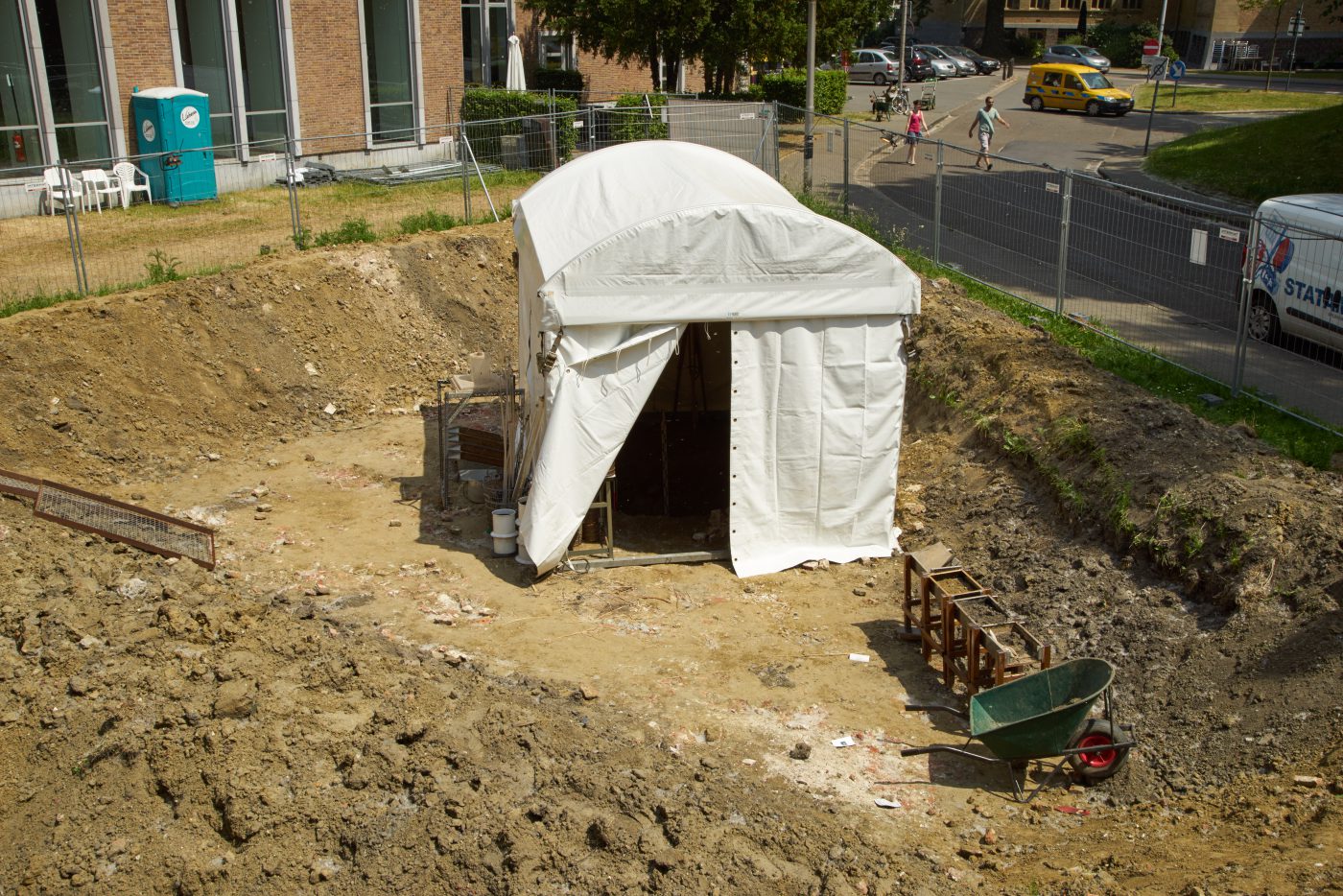
PLEASE NOTE – CLOSED NOW Verlust der Mitte, S.M.A.K, 20.05.2017 – 27.08.2017 – All photos by Dirk Pauwels, S.M.A.K, Ghent, Belgium, 2017
Ory Dessau


